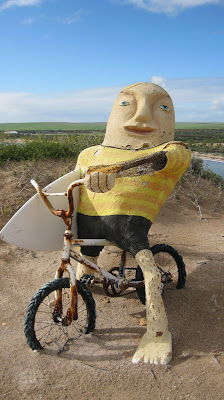Wednesday
18th July
After
packing up and farewelling Streaky Bay we made our first destination today
Murphy’s Haystacks. Murphy's Hay Stacks are known as Inselburgs and were
weathered and sculpted into their present form about 100,000 years ago. Geologists say the Hay Stacks are composed of pink granite from the Hiltaba
suite of rocks which were laid down some 1500 million years ago. These
beautiful pink granites were formed at a depth of 7 to 10 kilometres below the
earth's surface.
Today when we look at Murphy's Hay Stacks we see these Hiltaba
granites exposed on the surface. Clearly a very great deal of erosion has occurred
since the granite's formation. Local legend says that
Murphy's Hay Stacks acquired its name from an Irish agricultural expert who saw
this landmark in the distance whilst travelling on a coach. Apparently the
learned Irish gentleman was very impressed and informed his fellow passengers
that the farmer must have harrowed his land to produce such a great abundance
of hay! The original farmer of the land
was a Mr. Murphy and to this day the landmark is known as Murphy's Hay Stacks.
Elliston was the next town on the route and again had a
wonderful hall fully clothed in murals, even the toilets used local icons to
grace their walls. Locally it is believed to be named after the writer and
educator Ellen Liston who was born in
England in 1838 and emigrated to South Australia in 1850. She was a governess
working on a local property (Nilkerloo) owned by John Hamp.
Another attraction of which Elliston can be proud is the
sculptures along the Great Ocean Drive.
This road was unsealed and quite hilly in places, and at one stage we
were descending the road with nothing in sight apart from the ocean – an
optical illusion but nonetheless quite heart stopping. The sculptures are
permanent exhibits and varying in composition and interpretation.
 We particularly liked Mara, who in Latvian
tradition is considered the mother of the Earth, the provider of water and
milk, a protector of livestock and was thought to be present at birth and
deaths. In total contrast was this surfie dude and the larger than life thongs.
We particularly liked Mara, who in Latvian
tradition is considered the mother of the Earth, the provider of water and
milk, a protector of livestock and was thought to be present at birth and
deaths. In total contrast was this surfie dude and the larger than life thongs.
We found a great spot to camp for the night and of course a
fire was our companion for many hours as we contemplated, star gazed and warmed
ourselves.




